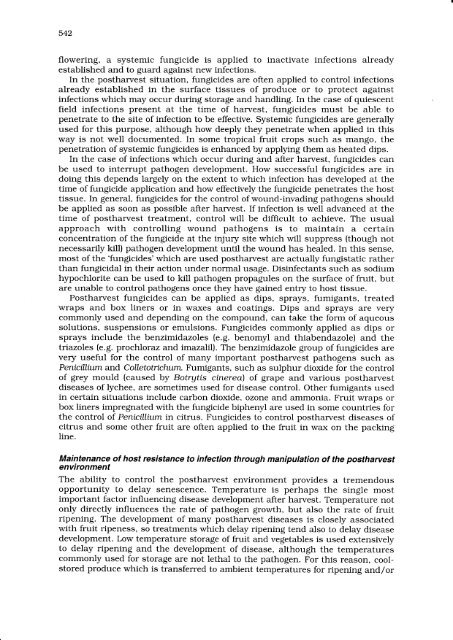POSTHARVEST DISEASES OF FRUIT AND VEGETABLES Lindy ...
POSTHARVEST DISEASES OF FRUIT AND VEGETABLES Lindy ...
POSTHARVEST DISEASES OF FRUIT AND VEGETABLES Lindy ...
You also want an ePaper? Increase the reach of your titles
YUMPU automatically turns print PDFs into web optimized ePapers that Google loves.
542<br />
flowering, a systemic fungicide is applied to inactivate infections already<br />
established and to guard against new infections.<br />
In the postharvest situation, fungicides are often applied to control infections<br />
already established in the surface tissues of produce or to protect against<br />
infections which may occur during storage and handling. In the case of quiescent<br />
field infections present at the time of harvest, fungicides must be able to<br />
penetrate to the site of infection to be effective. Systemic fungicides are generally<br />
used for this purpose, although how deeply they penetrate when applied in this<br />
way is not well documented. In some tropical fruit crops such as mango, the<br />
penetration of systemic fungicides is enhanced by applying them as heated dips.<br />
In the case of infections which occur during and after harvest, fungicides can<br />
be used to interrupt pathogen development. How successful fungicides are in<br />
doing this depends largely on the extent to which infection has developed at the<br />
time of fungicide application and how effectively the fungicide penetrates the host<br />
tissue. In general, fungicides for the control of wound-invading pathogens should<br />
be applied as soon as possible after harvest. If infection is well advanced at the<br />
time of postharvest treatment, control will be difficult to achieve. The usual<br />
approach with controlling wound pathogens is to maintain a certain<br />
concentration of the fungicide at the injury site which will suppress (though not<br />
necessarily kill) pathogen development until the wound has healed. In this sense,<br />
most of the 'fungicides' which are used postharvest are actually fungistatic rather<br />
than fungicidal in their action under normal usage. Disinfectants such as sodium<br />
hypochlorite can be used to kill pathogen propagules on the surface of fruit, but<br />
are unable to control pathogens once they have gained entry to host tissue.<br />
Postharvest fungicides can be applied as dips, sprays, fumigants, treated<br />
wraps and box liners or in waxes and coatings. Dips and sprays are very<br />
commonly used and depending on the compound, can take the form of aqueous<br />
solutions, suspensions or emulsions. Fungicides commonly applied as dips or<br />
sprays include the benzimidazoles (e.g. benomyl and thiabendazole) and the<br />
triazoles (e.g. prochloraz and imazalil). The benzimidazole group of fungicides are<br />
very useful for the control of many important postharvest pathogens such as<br />
PeniciLLium and CoLLetotrichum^ Fumigants, such as sulphur dioxide for the control<br />
of grey mould (caused by Botrgtis cinerea-) of grape and various postharvest<br />
diseases of lychee, are sometimes used for disease control. Other fumigants used<br />
in certain situations include carbon dioxide, ozone and ammonia. Fruit wraps or<br />
box liners impregnated with the fungicide biphenyl are used in some countries for<br />
the control of PeniciLLtum in citrus. Fungicides to control postharvest diseases of<br />
citrus and some other fruit are often applied to the fruit in wax on the packing<br />
Iine.<br />
Maintenance of hosf resistance to infection through manipulation of the postharvest<br />
environment<br />
The ability to control the postharvest environment provides a tremendous<br />
opportunity to delay senescence. Temperature is perhaps the single most<br />
important factor influencing disease development after harvest. Temperature not<br />
only directly influences the rate of pathogen growth, but also the rate of fruit<br />
ripening. The development of many postharvest diseases is closely associated<br />
with fruit ripeness, so treatments which delay ripening tend also to delay disease<br />
development. Low temperature storage of fruit and vegetables is used extensively<br />
to delay ripening and the development of disease, although the temperatures<br />
commonly used for storage are not lethal to the pathogen. For this reason, coolstored<br />
produce which is transferred to ambient temperatures for ripening and/or






![[Compatibility Mode].pdf](https://img.yumpu.com/27318716/1/190x135/compatibility-modepdf.jpg?quality=85)










